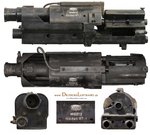Shortround6
Lieutenant General
Joules is an indication of the power of a cartridge, as in the amount/type of propellant/s used. It is certainly not absolute and a fair amount of jiggery-pokery can be done with light high speed projectiles vs heavy slow ones but a cartridge with a standard loading of 28,000 joules is never going to come close to the projectile weight/velocity combinations of a 48-51,000 joule cartridge.
A bit like comparing a 30-30 to a 30-06.
A 20mm gun with 45-52,000 joules of energy firing any sort of standard shape and weight shell is going to have much better "long range hit probability" than a 20mm gun with 30,000 joules because it has higher initial velocity and thus shorter time of flight to a given distance.
The troubles the Hispano had in US service are well known and the cure is also well known, what is not known is why US ordnance steadfastly refused to implement the fix (shorten the chamber about 1 mm in length so the firing pin gets a better hit and greatly reducing the number of misfires).
And strangely enough the British found that inert 20 mm projectiles crashing through aircraft structures were more effective than HE shells that detonated too quickly on the skin of an aircraft and failed to penetrate before exploding. Good size hole in skin doesn't always mean structural failure.
The best solution was a high velocity, high HE capacity projectile with a properly functioning fuse fired from a reliable cannon at a high rate of fire. Trouble was nobody was able to combine all five attributes at the same point in time. In fact in the early part of the war some cannon only had one or two of the 5.
A bit like comparing a 30-30 to a 30-06.
A 20mm gun with 45-52,000 joules of energy firing any sort of standard shape and weight shell is going to have much better "long range hit probability" than a 20mm gun with 30,000 joules because it has higher initial velocity and thus shorter time of flight to a given distance.
The troubles the Hispano had in US service are well known and the cure is also well known, what is not known is why US ordnance steadfastly refused to implement the fix (shorten the chamber about 1 mm in length so the firing pin gets a better hit and greatly reducing the number of misfires).
And strangely enough the British found that inert 20 mm projectiles crashing through aircraft structures were more effective than HE shells that detonated too quickly on the skin of an aircraft and failed to penetrate before exploding. Good size hole in skin doesn't always mean structural failure.
The best solution was a high velocity, high HE capacity projectile with a properly functioning fuse fired from a reliable cannon at a high rate of fire. Trouble was nobody was able to combine all five attributes at the same point in time. In fact in the early part of the war some cannon only had one or two of the 5.

